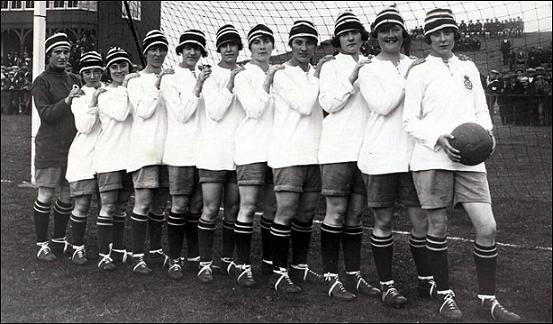
It isn’t recorded in the the 1922 Spalding Guide, nor at the American Soccer History Archives, but in 1922, some 5,000 soccer fans turned out at Philadelphia Baseball Park to see the first visit by an international women’s soccer team to play in Philadelphia.
They were called Dick, Kerr Ladies and they were from England.
Origins
The first reported women’s soccer match took place in Edinburgh, Scotland in May 1881. In “Colleen Bawns and Bonnie Lassies,” his chapter in the anthology Soccer Frontiers: The Global Game in the United States, 1863-1913, Brian D. Bunk recounts the first women’s match in the United States, which was played in San Francisco in December 1893. The British Ladies Football Club was organized in 1894 and played nearly one hundred exhibition matches before dissolving in 1897. The first reported women’s soccer match in Philadelphia, was played in October 1907. Such developments were fitful and teams, with the exception of the British Ladies Football Club, rarely remained together beyond a game or two games. This began to change with the advent of the First World War, which saw an unprecedented number of women entering the workforce to replace men who had been called to fight in the global conflict. That influx of women workers was followed by the formation of a number of workplace-based women’s teams in England. By the end of the war, Dick, Kerr Ladies was widely recognized as one of the best.
Originally a manufacturer of electric rail and tramway equipment, Dick, Kerr & Company was converted into a munitions manufacturer during the war. From informal kickabouts during work breaks, the founding members of the team that would become Dick, Kerr Ladies played their first official match on Christmas Day, 1917, at Deepdale, then home of Preston North End in Lancashire. In front of 10,000 spectators, the team defeated another women’s team from a local foundry, 4–0, with the proceeds from the match donated to a local hospital.
Dick, Kerr Ladies continued to play other women’s teams in charity matches after the Armistice in November, 1918. In 1920, they traveled to France to play a series of matches against women’s teams there. After returning to England, they played in front of 53,000 spectators at Goodison Park in Liverpool on Boxing Day, defeating St. Helen’s Ladies 4-0. In 1921, Dick, Kerr Ladies played 67 matches in front of nearly 900,000 spectators—an average of nearly 13,500 people per game—all while also working full time factory jobs.
And then the FA stepped in.
Rumblings had been appearing in the press that not enough money was being directed to the charities who benefited from women’s games. Dick, Kerr Ladies also gained no friends in high places when they began to play charity matches for workers struggling to feed their families during the 1921 Miners Lockout. But the issue for many people—which is to say for many men who felt threatened by the social changes that occurred during the war—was simply the idea of women playing a “manly” sport like soccer. It didn’t help that women’s teams like Dick, Kerr Ladies were outdrawing many men’s teams.
On December 5, 1921, the FA banned member clubs from allowing women’s teams from playing on their grounds under penalty of sanction. While mention of financial questions was included in the unanimous ruling, the language that opened the announcement was more to the point:
Complaints having been made as to football being played by women, the council feel impelled to express their strong opinion that the game of football is quite unsuitable for females and ought not to be encouraged.
That the FA’s pronouncement was based on “strong opinion” rather than fact is revealing to the reader today. But at the time, the FA had no trouble finding male and female doctors willing to go on record as saying a “women’s physical frame” could not withstand the “violent leg strain” and “jerky movements” of a “rough game” like soccer.
While Dick, Kerr Ladies continued to play charity matches on non-league grounds, new opportunity soon came from across the Atlantic.
To America
Dick, Kerr Ladies disembarked in September of 1922 for a North American tour that was scheduled to include some 24 matches over four months. The tour was backed by the Brooklyn Football Club and promoted by David Brooks, a former Newcastle United player, and was to begin in Canada before continuing in the US with stops along the East Coast and as far west as Chicago, Detroit, and St. Louis. But, upon arriving in Quebec, the team was informed that the Dominion of Canada Football Association had refused to support the tour and had banned the team from playing in Canada. At the association’s annual general meeting in Winnipeg only days before the team’s arrival, a resolution had passed which said, “We do not approve of the proposal of Ladies Football.” It was terribly disappointing news but given the influence of the FA, and the chauvinism of the day, it may not have been surprising.
From 24 matches over four months, the tour was now reduced to a handful of games over several weeks. As if that news wasn’t bad enough, Dick, Kerr Ladies was also informed that it would be playing men’s teams in the US—including professional teams of the recently formed American Soccer League (ASL). There simply were not enough women’s teams of sufficient quality available to play the visitors.
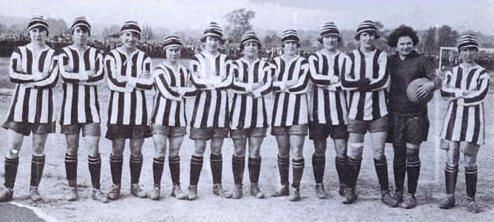
Dick, Kerr Ladies opened the tour against Paterson Football Club on Sunday, September 24, losing 6–3. On Saturday, September 30, they tied J & P Coats FC 4–4 in Pawtucket, losing the following day 7–5 in New York City to Centro-Hispano. By now, the team had had enough of the current management of the tour. If the cancelled games and shoddy hotels booked for their accommodation weren’t enough, the team was being billed as coming from Newcastle. After hearing an appeal from the team, the United States Football Association (USFA), today known as the US Soccer Federation, agreed to step in and take over the management of the remainder of the tour.
The 1922 Spalding Guide reports, “The finances, routing and other details of the tour by the management of the Brooklyn Football Club became so muddled that in order to protect against the tourists’ being stranded in this country, the management of the tour was taken over by Mr. Thomas Bagnall, appointed U.S.F.A representative to accompany the team, and the tour was reduced to seven games, confined to the Atlantic States.” (The tour eventually included nine games.)
Conditions improved considerably and so did the team’s record, with Dick, Kerr Ladies going on a five game unbeaten streak that included two draws: 4–4 against Washington Stars on October 8 and 2–2 against Fall River Marksmen on October 15; and three wins: 5–4 against New Bedford Whalers on October 11, 8–4 against New York FC on October 14, and 4–3 against Baltimore SC on October 22.
On November 4, 1922, Dick, Kerr Ladies would play Philadelphia Field Club of the professional ASL in the final game of the tour.
The game almost didn’t happen.
In Philadelphia
On August 14, 1922, Philadelphia Inquirer soccer reporter Levi Wilcox reported the “soccer magnates” of the Football Association of Eastern Pennsylvania and District, the regional governing body of soccer affiliated with the USFA, were refusing to sanction a Dick, Kerr Ladies game in Philadelphia. According to “a well-known coach and former player,” the reason “there was opposition to the women playing here was the fear that a victory for the women players might hurt the sport in the colleges and schools.” In other words, the leaders of the Eastern Pennsylvania and District were worried a Dick,Kerr Ladies victory over a local men’s team would be so humiliating as to turn young male players away from the game.
Wilcox proceeded to eloquently dismantle such a view, pointing to the fact that “basketball, hockey and even polo matches have been played in this city between men and women players” with no harm to the development of those sports. More generally, Wilcox reminded his readers that the USFA had sanctioned the Dick, Kerr Ladies tour:
The National Commission must have been of the opinion that if the appearance of these feminine dribblers did not help foster the game that it would not retard its progress or they would never have granted the request…We fail to fathom where these women players pitted against a picked team will hurt the progress of the game one iota.
Indeed, Wilcox argued that, if the game was thoughtfully scheduled and properly promoted, it could prove to be a boon for soccer in Philadelphia: “A match of this sort will be a novelty and will be the means of encouraging many a spectator to travel to Disston Ball Park for the purpose of witnessing these women in action, who probably has never before seen a soccer match.”
On August 28, Wilcox reported “the Eastern moguls have refused sanction for a game here.” For Wilcox, this was yet another reason for a leadership change at the Eastern Pennsylvania and District:
New blood is badly needed in the government of the game in this city. Those who have been at the helm the last few years have apparently worn themselves thread bare and on that account are shorn of new ideas in keeping pace with the progress of the game. Instead of officials being elected every year who have had their schooling in other countries they should be stripped of their official robes and give Young America a chance.
Wilcox reported on September 13 that Philadelphia was still on the schedule for the Dick, Kerr Ladies tour “but as the Eastern district moguls are not anxious to sanction a game between these women and a picked team in this city, nor any other team for that matter, local soccer fans are to be deprived of witnessing this women’s team play unless, of course, they make the trip to one of the cities where they are scheduled.” But on October 24, the Inquirer reported that Thomas Scott, manager of the city’s ASL’s team, had announced arrangements had been made to host Dick, Kerr Ladies at Philadelphia Ball Park on November 4.
On October 30, Wilcox continued his positive promotion of the game, describing the visitors as “one of the strongest ever sent to this country” — male or female. He continued,
Instead of the tourists playing the game of the pink tea order as some might imagine, they charge as keenly as the men players while their combination play rivals that of some of the English leaguers.
They are also exceptionally fast on the ball while their control from one player to another is so accurate that one would imagine that the ball was literally glued to their feet…Strong as the Phillies might be with well-known rushing and bustling tactics, they will find these women will not give them an inch of ground in that respect. The team is built both for speed and is also capable of holding its own when it comes to roughing it.
Dick, Kerr Ladies arrived in Philadelphia on Tuesday, October 31, settling into the Washington Hotel to prepare for their Saturday match at Philadelphia Baseball Park. Wilcox reported on October 31 the team’s Philadelphia stay would be “the first time since they arrived in this country that the players have been fortunate enough to stay in one city more than an over-night stand.” Wilcox wrote on November 1,
The players when interviewed last night were rather modest regarding their abilities in the dribbling game. Even Captain Alice Kell, who plays right full back would not commit herself anent the chances of her team defeating the Phillies. She stated however, that providing the Phillies play the game without resorting to foul tactics that they would give the spectators a real treat in the art of combination play.
The “Phillies” were the Philadelphia Field Club, the ASL team that had won the inaugural 1921-22 season championship of the new professional league. But the 1922-23 version was a much different team than the one that had played the previous season. That 1921-22 team was basically Bethlehem Steel FC, whose owners had moved the team to Philadelphia with the expectation of making a killing at the gate. While the team cruised to the league championship—Harold Brittan and Tommy Fleming combined for 39 of the team’s 72 goals while goalkeeper Findlay Kerr finished the season with a 1.5 goals allowed average with 7 shutouts in 24 games—attendance was below expectation. In the 1922-23 season, Bethlehem entered the ASL under their own name and former BSFC/Philadelphia FC players like Brittan and Fleming went to other deep-pocketed clubs like Fall River Marksmen and J & P Coats in Pawtucket.
Gameday
Wilcox wrote in his match report, published in the Philadelphia Inquirer on November 5, that while a large crowd was expected for the game,
It was not expected, however, that even though this girls’ aggregation had defeated every fair sex team in England the last three years that they would prove a match for the Phillies. They gave the locals a corking game, however, besides giving the crowd a rare treat in witnessing them pass and dribble the ball in real English league style.
Some 5,000 spectators were on hand when the contest kicked off. The game started poorly for Dick, Kerr Ladies with Philadelphia scoring three minutes after the opening whistle. After only 15 minutes of play, the scoreline was 2–0. Wilcox described, “With two goals to the good and the game only fifteen minutes old, this would have discouraged many a man’s team. Not so with this English combination, for they got right down to hard playing.”
By the time 25 minutes had elapsed, the score was 2–1. But the visitors soon conceded another goal. “The English girls then began the aggressive,” Wilcox wrote and before the halftime whistle was called, the score was 3–2.
If many in the crowd had shown up for a novel spectacle, the play of the Dick, Kerr Ladies was winning them over. Wilcox wrote that when they leveled the scoreline three minutes after the restart, “the crowd were with the English girls almost to a man, woman, and child.”
After that, play continued to be wide open. “Rapid-fire scoring then took place before the end of the game by both teams,” and five more goals were scored before the final whistle.
In the end, it was Philadelphia FC 6–5 Dick, Kerr Ladies.
Respect
Did Philadelphia play Dick, Kerr Ladies with the same intensity with which they would play a men’s team? It is safe to assume they did not. Wilcox notes in his match report that Philadelphia “did not charge the players as they generally handle their other opponents,” and earlier reports from the tour also describe male players going easy on their female opponents. The Pawtucket Times reported on October 2 after the 4-4 draw there, where local matches were postponed to increase attendance and the match was witnessed by “At least 9000” spectators,
The bonny girls, clad in regulation uniforms, were no real match for the Coats eleven, and yet they succeeded in outwitting the team to the extent of pulling a tie. It was clearly evident from the start of the contest that the home men, with commendable chivalrous intent, were out to annex no more goals than was absolutely necessary. Easy scores were forfeited through the employment of devious tricks, such as booting the ball over the net or offside. Yet the Coats intended to win, perhaps by one or two scores. In the last few minutes of time, however, the girls played brilliantly…Whether or not the Coats could have run up a big score is immaterial as the vast crowd seemed perfectly satisfied with the termination of the game and gave the girls a great ovation…It must not be supposed that the visiting eleven did not put up a great exhibition.
It is likely that male players found new respect for their opponents. Paterson goalkeeper Peter Renzulli later recalled, “We were national champions and we had a hell of a job beating them.” As Wilcox wrote in his match report, “The English team not only gave an exhibition of soccer that is seldom witnessed on local grounds, but they demonstrated that women can play soccer the same as men—and to say they play it well is only putting it mildly on their exhibition yesterday.”
Wilcox continued to express how impressed he was with the skill of the players in another article on November 9. “From what we witnessed last Saturday, these English girls, while not as robust as the men players, which is to be expected from the weaker sex, have more of the game in their bonnets than any team we have witnessed play in this country, with the exception, of course, the English elevens which have played here.” Even with archaic references such as “English girls” and “the weaker sex,” Wilcox’s respect for the women players is evident.
Wilcox also reaffirmed his belief that the Dick, Kerr Ladies’ match would prove to be a boost for soccer in Philadelphia generally. “The match between the Phillies and the English soccerettes at Philadelphia Ball Park last Saturday did much to foster the grand old dribbling game, particularly among a number of fans who went there expressly for the novelty of girls playing against the stronger sex. Among the thousands were a large number of spectators who had never before seen a soccer match and who might become ardent followers of the game after that grand exhibition they lamped last Saturday, particularly from the girls’ side.”
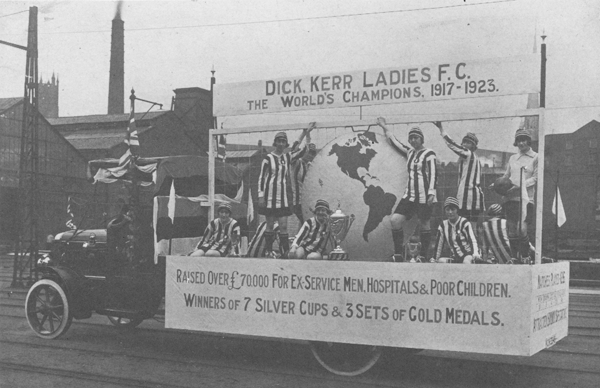
After
Over several articles Wilcox made clear his belief even more spectators than the 5,000 who had attended the game would have turned out if only the officers of the USFA-affiliated Football Association of Eastern Pennsylvania and District had seen fit both to sanction the game and also postpone local league matches.
The effect the absence of the local soccer governing body’s sanction had on attendance soon was overshadowed by another issue. On November 19, Wilcox reported that the “Eastern District moguls” had “suspended the Phillies indefinitely for having the audacity to play the English soccerettes, even after that trip had been sanctioned by the National Association.” For the Phillies, the suspension meant the team was forbidden to play any local teams under the governance of the Eastern District. And so, Hibernian withdrew from the scheduled Thanksgiving match against the ASL professionals rather than face sanction themselves.
Along with Philadelphia FC, Jimmy Walder, the legendary Philadelphia referee and former Philadelphia FC manager, was also suspended. The members of Pennsylvania Referee’s Association—”which was formed years before even the Eastern District was even thought of [and] has long had a standing in the community without a blemish”—resolved after “a huge majority vote” on November 24 to file an appeal against Walder’s suspension with the secretary of the Eastern District. If that didn’t work, an appeal would be made to the USFA.
Whatever the motivations behind the Eastern District’s refusal to endorse the Dick, Kerr Ladies match, the conflict after the game took on the form of a political turf war. Wilcox wrote on November 25, “It is the first time in the history of soccer football in this country that a subordinate organization, as the Eastern District is a State body, has acted contrary to the rulings of the United States Football Association, the parent organization.”
Unsurprisingly, the Eastern District’s view of the situation was different. The Evening Public Ledger reported on Nov. 14 that, according to the Eastern District, it was impossible for Philadelphia FC to have received permission from the USFA to play the match “as the parent body cannot invade the territory over which it has jurisdiction.” The Evening Public Ledger report continued, “Local soccer men say if the ruling of the Eastern District is not upheld, soccer laws in America are a farce.”
It was a view without much support. Wilcox wrote on November 30, “every fair-minded soccer fan” in Philadelphia realized that the Eastern District had “pulled a ‘boner’” in sanctioning the Phillies and Walder.
Philadelphia FC finished the 1922-23 ASL season bottom of the table. After opening the season with a 3–1–1 record over the first five games, including a 2-1 win over Bethlehem Steel in the opener, Philadelphia lost 5–1 to Paterson the day after they played Dick, Kerr Ladies. It was game three of what would become a 19-game winless streak in the league. The winless streak actually stretched to 21 games for while Philadelphia closed out the season with victories over Brooklyn Wanderers, the league awarded the points from those games to Brooklyn after it was determined the Phillies had fielded an ineligible player.
Wilcox reported on November 9 the original manager of the Dick, Kerr Ladies tour, David Brooks, had decided to remain in Philadelphia and “throw his lot in with the Philadelphia Soccer Field Club” where he would “coach the players and also play in some of the important matches at full-back.” The records in Colin Jose’s American Soccer League, 1921-1930 indicate Brooks played five games for Philadelphia.
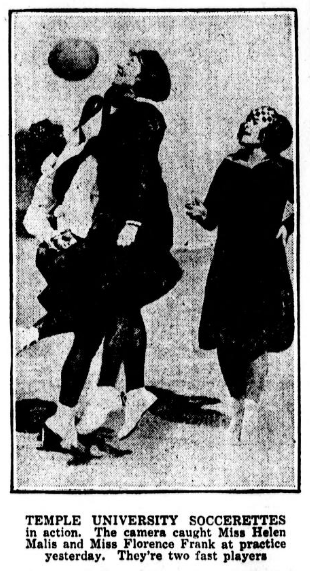
In her book In a League of their own!, Gail Newsham relates an account given by Herbert Stanley, who served as a secretary on the tour. According to Stanley, Brooks “had left his wife and family and cleared [England] without saying a word. He had been doing negotiations for the tour in secret, and this was his getaway.” Stanley said of Brook, “looking back I feel that for a most plausible rogue, David took the cake.”
Moving forward
Dick, Kerr Ladies remained in Philadelphia until the day before they disembarked for England from New York on November 9. Other teams had expressed interest in playing the English visitors; Wilcox reported promoters in Bethlehem and Wilmington, Del., were eager to host the team before their departure. But a USFA financial report in the 1923 Spalding Guide says “it was found that the guarantees offered were not sufficient to cover expenses.”
According to Wilcox, the team “were loath to leave this city after being entertained and treated in better style than in another city” since the start of their tour and that “the hospitality of local soccer fans will long be remembered.”
Dick, Kerr Ladies became Preston Ladies in 1926 and continued to play and raise money for charity until the end of the club in 1965. Between their founding in 1917 and demise in 1965, the team played 828 games, winning 758, drawing 46, and losing 24. 50 years after it had imposed its 1921 ban, the England FA finally recognized the women’s game in 1971.
But what of their impact on the development of the women’s game locally?
In a column on November 6, 1922, Wilcox writes, “We would travel many miles to witness those English soccerettes in action if they were pitted against a girls’ team. And it is a safe bet these girls would outclass their opponents.” But Wilcox noted in an article on November 9, that “women soccer players in this city are almost as scarce as hen’s teeth.” A photo in the November 1, 1922 edition of the Evening Public Ledger shows three “Temple soccerettes” but they were not part of an organized, varsity-level team.
The scarcity of women’s soccer in Philadelphia described by Wilcox remained true for decades after Dick, Kerr Ladies’ visit. Born in Kensington Kensington in 1933, National Soccer Hall of Famer Len Oliver said of his experience playing the game in 1940s and 50s,
Even if they were interested, girls were discouraged from playing both unorganized (“pickup”) and organized soccer (high school, college). For example, if a girl appeared to play in one of our street (or cemetery) soccer games, we would simply say, “No, this is not for girls!” So girls were discouraged at home from playing our sport, were discouraged by the pick-up players, and were unable to find high school or college teams because there were none. It was simply a “man’s game.” Unfortunately, because we lost a generation of potential female soccer players.
Oliver, who would later become a coach when his daughters developed an interest in the game, emphasized the importance of Title IX in opening up opportunities for girls and women to play soccer. The landmark legislation became law on June 23, 1972, just as the soccer boom that accompanied the early success of the first NASL was beginning.
To today’s soccer fan, it can be surprising to be reminded how slow the growth of the women’s game remained even after Title IX. By 1978 there was an Ivy League women’s soccer champion with other collegiate athletic conferences slowly adding women’s leagues through the 1980s and 1990s. At the international level, US Soccer finally fielded a senior women’s team in 1985 and the first Women’s World Cup—originally called the Women’s International Soccer Championship—was won by the US in 1991. Women’s soccer was finally recognized as an Olympic sport for the 1996 games in Atlanta where the US won the gold.
Meanwhile, women’s professional soccer continued its fitful struggle to find its place in the sports marketplace. Philadelphia Charge played three seasons in the Women’s United Soccer Association beginning in 2001 before the league’s collapse in 2003. Philadelphia Independence joined Women’s Professional Soccer one year after that league’s founding and played two season before the league folded in 2012. Philadelphia Fever participated in the short-lived Women’s Elite League, which was organized as a stopgap by Women’s Premier Soccer League after WPS folded. When the US Soccer-backed professional National Women’s Soccer League was announced for the 2013 season, a Philadelphia club was absent from the list of participating teams.
A version of this article originally appeared at Philly Soccer Page on May 8, 2013
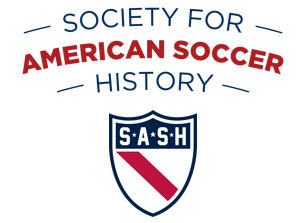
I am author of a forthcoming book about Carmen Pomiès, who fatured prominently in the DKL tour of the US in 1922.
I would like to use extracts from the SASH article about DKL in Philadelphia. Can you advide me of how to obtain approval for this?